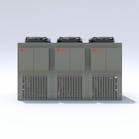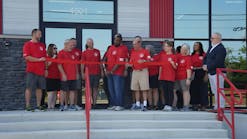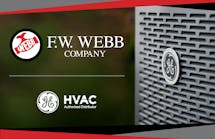There is no greater surprise to a writer than when he sets out on a quest for facts in a seemingly straightforward story only to discover it isn't what he thought it would be.
This story began as a roundup on major buying-group players in the HVACR industry.
The roundup occurred, but the semantics changed.
Not one of the groups to which I spoke described themselves strictly as a buying group. They either did not consider themselves to be one or no longer identified with that narrow definition. What they did confirm is that they had fulfilled the basic requirements of a buying group but had much more to offer. For the record, while there isn't any “official” definition for buying groups, presumably, we can all agree upon a commonly accepted view that wholesalers who form such groups do so to obtain a better pricing structure for products they purchase from vendors. (I've also provided a nice working definition from an expert on the subject.)
Most of the groups I spoke with describe themselves as a marketing or co-op group. Indeed, all share a listing under the heading of HARDI's website. I'm pleased to say that ALL are HARDI members.
Just to give you a sense of how varied these definitions can be, the National Cooperative Business Association (www.ncba.coop) lists four different types of cooperatives with a definition for each.
Below we've provided you with a capsule look at each buying group. We've also provided a matrix that gives you a snapshot look. If you're not a member of a buying/marketing/cooperative group, this is a good time to consider joining one.
Affiliated Distributors
In October 2005, Affiliated Distributors (A-D), which describes itself as the largest wholesale buying and marketing group in North America, began discussions with the HVAC Group to join its organization. The merger became final in Jan. 1, 2006, and former founding member of the HVAC Group, Doug Young, became the chairman of A-D's newly formed HVAC division's executive committee. Young was familiar with buying groups. In 1996, he formed, along with six other wholesalers (growing to 22 members) scattered across the country, a regional buying group they named the HVAC Group. They formed for the basic goal of every buying group: discounts or rebates from manufacturers.
The merger with Affiliated Distributors occurred because the sheer size, offerings and opportunities within a larger structure were too attractive to ignore, Young says. “We get all these great services from A-D, and because of their size, we also get 106 percent of the rebates back without having to pay any dues.”
Young, president of Grand Rapids, Mich.-based Behler-Young Co., points out several concrete reasons for forming a buying group and why ultimately his group joined forces with Affiliated Distributors. First, there was the issue of pricing and rebates. He wanted a structure that allowed for local pricing which can keep pace with the competition and cover freight and other costs. He was also interested in a rebate structure that links to sales both as a group and as an individual company. This allows a company, for example, to earn rebates on local or regional sales even if the wholesaler as an individual is not experiencing the same success. Also connected to this issue is a buying group's ability to offer services that all distributors use and thereby lower costs, such as auto, insurance and gasoline deals.
The second opportunity is networking, a common term but one that Young maintains is even more important to its members than the pricing/rebate structure. “I'm not going to tell my local competitor what I'm doing, but I might be willing to tell someone at the other end of the country,” says Young. “This exchange of information is enormously helpful to your business when you're talking to other successful executives.”
The third reason is the sales and marketing component. While challenges exist in this area if the product lines differ, this allows for a reduction of cost in developing programs. “We had some marketing programs, but Affiliated Distributors provided a well-established marketing program that has been successful in growing sales and gaining market share. The focus is on joint planning between the distributor and our suppliers,” Young shares. This program tracks the effectiveness of marketing events, providing data on activities completed and progress to goals via A-D's private extranet that connects the membership.
Technology also played a vital role in deciding to choose Affiliated Distributors because its size and experience offer economies of scale to help reduce supply chain cost by automating transactions and making them smoother, Young says.
Affiliated Distributors sums up its advantages by noting that “our unique structure enables us to leverage a common back office (finance, accounting, marketing, IT, meeting planning, executive, etc.) over multiple industries and provide value-added services and resources to our members and suppliers on an extremely efficient basis.”
“While we were successful in the past, joining with Affiliated Distributors made a great deal of sense because of their size and influence,” says Young. “We expect to be a vital component in the Affiliated Distributors family.”
In addition to HVACR equipment and supplies, Affiliated Distributors also participates in four other industries, including electrical supplies, industrial supplies, plumbing supplies and pipe, valves and fittings.
What is your long-term vision?
To provide leading independent distributors with the support and profitability that enable them to remain independent and successfully compete with national chains.
What is the single unique attribute about your organization?
By leveraging the power of leading independents in multiple industries, we provide our members with a wide range of proven marketing programs and cost-saving services while distributing over 105 percent of the supplier rebates we generate (without the need for members to pay annual dues).
Blue Hawk
Lance Rantala, CEO of Blue Hawk, describes their organization as a member-owned, 100 percent democratically controlled business, with membership offered to those who need its service. While he accepts the reality that different definitions exist under the broad umbrella of cooperative, marketing or buying group, he succinctly describes what is probably the fundamental goal of all such organizations in the HVACR industry. “We're trying to protect and preserve the voice of the independent distributor,” Rantala says. As the supply chain consolidation trend continues, it affects everyone, especially the strength and influence of the independent wholesaler, he says.
Blue Hawk, the newest major entry into the buying, marketing or cooperative group, officially launched in May 2005. What sets Blue Hawk apart from similar organizations, according to Rantala, are the criteria it created for membership. Potential members must be privately held, financially healthy and an HVACR wholesaler. Blue Hawk's membership is by invitation only. “We want members working with members that they would like to bring into the cooperative community,” says Rantala. While members might compete within the same market, the strength that their combined membership offers is not a real threat to other independent wholesalers. Not surprisingly, Blue Hawk offers approved vendor programs as well as sharing of best practices, educational and training seminars, and networking events at their annual spring and fall conferences. Blue Hawk has access to key vendor decision-makers while a nonaffiliated independent wholesaler might not get closer than a manufacturer's rep or regional supervisor.
Rantala believes that Blue Hawk's rapid growth links directly to its willingness to allow a bullish approach to new members in the same general territory. They are, however, more circumspect about bringing preferred vendors into the program. “We look for custom-controlled growth with the vendor partners,” he says. “We're not interested in just piling up vendor deals but are more interested in high-quality vendors that the members will support.
“The founding members formed Blue Hawk to meet the competitive challenges of the marketplace,” says Rantala. “While the day of the solo, family-owned HVACR is not over, the challenges become increasing more difficult for those that stand alone.”
Blue Hawk is a HARDI member and was particularly enthused about the 2006 conference in Palm Desert. In the future, it will hold its annual fall meeting the day after HARDI's annual conference.
Controls Group North America
When people ask Jim Hayman about Controls Group North America (CGNA), the director of business development dispels an old notion. “We're not a buying group, we are a marketing group,” he says. He concedes that when the group started in 1983 with 12 members, it had all the attributes of a basic buying group. “They [the original organizers] said let's combine our purchasing power to increase our influence with manufacturers.”
About nine years ago, CGNA decided to move beyond the identity of a buying group and expand its services. In a typical buying group, the organization requires certain levels of discounts and rebates from their manufacturers, and in exchange, the distributors will commit to a specific volume of purchases. “We do not require our preferred vendors to hit a predetermined discount level with the group, and we don't require our members to purchase a set quantity from them,” Hayman says. “Instead, CGNA provides marketing programs to promote both their preferred vendors and members to their contractor customers,” he added.
So what is CGNA? Well, the most telltale sign is its name. All 35 of their member distributors specialize in HVACR controls. Indeed, they describe themselves as the largest network of independent controls distributors in the nation. What they offer is a four-pronged program as a marketing group. These activities include: marketing and public relations; technology; training and education; national networking.
On the marketing side, their in-house graphics designer allows them to develop direct mail programs, advertising and electronic communications. They also provide public relations, factory surveys and website assessment for their members. CGNA believes that publicizing itself via marketing programs and the media makes sense when trying to establish a presence among its customers and manufacturers.
They also maintain an online inter-member shared inventory for all 130 of their members' locations along with a print, online and digital catalog of 140 manufacturers. CGNA also offers customized factory training at members' facilities and online. These sessions focus on new products and technology, sales and customer service skills to maintain a competitive edge, says Hayman.
The final appeal of CGNA is its networking opportunities. “We have far more influence in the industry with 35 companies than any of our members could individually,” says Hayman. The CGNA members are able to meet several times a year in person for events, as well as participate in conference calls, board meetings and committee calls that allow them to talk to their peers about their industry and their products. It's the perfect opportunity to discover what works for their wholesalers and what doesn't, he says. Hayman describes this exchange of ideas and information as a vital component to staying on top of change in the industry. You've got the top controls wholesalers in the country sharing ideas, and what could be better than that, he asks?
What is your long-term vision?
Our long-term vision is for our network of CGNA distributors to increasingly become the preferred channel for controls manufacturers and the primary resource for controls contractors across the nation.
What is the single unique attribute about your organization?
Whether it is for one building or a national account, CGNA distributors are all about complete controls solutions. Through continual training and extensive factory certification, CGNA members provide their customers with the highest level of controls expertise in the industry.
Embassy Group Ltd.
Embassy Group Ltd. has a dual identity. A very well-known player in the plumbing industry since 1991, it is just beginning to boost its presence in the HVACR industry.
In its early days, Embassy focused on wholesalers who were heavily involved in plumbing, valves and fittings. As it began to look for new growth opportunities, it realized that 35 of its 62 members also have a reasonable HVACR side to their business. “We saw this as a natural focus,” says Walter Gumm, Embassy Group Ltd. president.
In August 2006, the group reached a milestone when its board of directors decided to pursue the creation of a specific division for “pure” HVACR wholesalers.
Gumm describes the organization as the premier buying group in the plumbing industry and is confident that its focus and success in the industry will nicely complement its entry into HVACR. With more than $3 billion in sales that includes some crossover sales between the two industries, adding more independent HVACR distributors and vendors to the group is a new goal.
Like many other groups, an acceptable level of financial stability and compatibly with other members are key ingredients for membership. But an even more important requirement is geography. Unlike some buying groups, Embassy limits the amount of overlap in a member's territory.
The geography card should indicate that Embassy is looking for controlled growth. “Our profile is to look for quality wholesalers because we have a structure that allows for a profitable structure that offers many benefits to the members and the vendors,” Gumm says. It mandates membership participation in the committee process in management and activities.
All members are owners with one share of stock. “We have a great networking system, and in March at the annual conference, we will guarantee all our vendors valuable face time with our members,” he says. “This March will be the first time that Embassy has set aside a special day just for HVACR vendors.”
Members are also active in promotions, and a basic guiding philosophy is that the financial benefit of belonging to the organization is returning its earnings back to the owners after operating expenses. With only three employees, Gumm says, “We are probably the leanest operation out there, because we keep our overhead down and benefit from our technology.”
“We spend a lot of money on technology, and when you get to our universal page [on the Internet], behind it is a lot of information, including vendors' reports and what wholesalers are buying,” Gumm says. “We don't have to fumble around with a lot of paper.
“When you join this group, you're on the same playing field as some of the national organizations. Indeed, we consider ourselves a national organization with strong regional members. That brings a great deal of benefit to the membership,” he says.
What is your long-term vision?
Continue to grow through acquiring new members and vendors in the plumbing, PVF and HVACR industry, and to be a meaningful organization to those connected with Embassy Group Ltd.
What is the single unique attribute about your organization?
We are a $3.2 billon corporation consisting of the premier wholesalers and vendors in the industry, and we operate with a total of three employees, which makes us the most efficient buying group in the plumbing, PVF and HVACR industry.
Key Wholesaler Group Association
A key component of the Key Wholesaler Group Association is its commitment to remaining low- key (if you forgive the pun) at a time when some buying groups appear to being making more of a splash in the marketplace.
“We're the low-key member,” says Mark Chavez, its personable president, who describes the group as tightly knit and intent on returning all of the profits, less annual expenses, right back to the group's 22 members. “These are the smartest guys I've ever met in the industry,” says Chavez, who has been in business for more than 27 years.
Key has one distinct difference from other buying groups. All members must be Copeland distributors. Another difference is that they are not seeking new members.
While they publish their members' names on the website, they decline to publicize who their vendors are or the nature of the programs they obtain because of confidentiality agreements. “Some of our vendors don't want us to publicize our programs,” Chavez explains. “We have a simple philosophy here. We don't want to beat up the vendors but we do expect a good price. It has to be a win-win for both groups. We're not expecting a better price, but we feel capable of getting the price the national guys get.” Key declines a reasonable number of programs with vendors each year if they're unconvinced that both parties really benefit.
Chavez acknowledges that his group does more than just obtain rebates from vendors. Members also share marketing programs and exchange ideas. In 2007, they will have achieved a goal of complete inventory sharing among their 334 member branches, allowing a distributor to quickly turn to a fellow member for a much-needed part. They also insist on having the counsel of a top-notch buying group attorney at all formal meetings so that they do not run amiss of antitrust rules that often apply to such gatherings.
It might seem unusual that a buying group has actually closed its doors, at least for now, to new members, but Chavez points out that while business is about profit, at Key the compatibility and willingness to share confidential information remain highly important and subjective elements that you can't find on a balance sheet. “The number of our members is less important than sharing the Copeland brand and a high degree of harmony,” Chavez says. “Our members are highly successful, and when they run into a problem or anticipate one, they can turn to a fellow member who provides background and perspective as they shape their own solution.” With the exception of one participant, all are family- owned, second- or third-generation members in the group.
“There are other fine buying groups,” says Chavez, “but we believe that we're really owner-owned in the sense that, less the cost of operating the group, the remainder of the money goes back to the member/owners.”
What is your long-term vision?
To continue to grow and evolve as our industry changes continuously. To share the strategies of successes and controlling costs that come with a group of our size.
What is the single unique attribute about your organization?
Holding on to the high integrity values to customers, employees and vendors that have always been the backbone of independent HVACR distributors. Our definition of short- term and long-term plans and actions is much different than from some distributors.
WIT & Co.
Barry Portnoy wears two big hats. He's the president of Piscataway, NJ-based Aaron & Co. Inc., a plumbing and HVACR wholesaler, and he is the chairman of the Heating, Refrigeration and Air-conditioning committee for WIT & Co., which negotiates programs with manufacturers. If anyone believes in the WIT program, it has to be Portnoy. He resigned from two similar groups (which he gracefully declines to name) and feels that he's found a home in WIT.
Unsurprising, Portnoy also is dismissive of the idea that Wit is just a buying group. “We have the functions of a buying group, but our membership brings much more,” he says.
Wit provides medical and business insurance, and is heavily involved in the marketing end, too, says Portnoy.
One important difference with Wit, according to Portnoy, is that they do not negotiate price.
“We negotiate rebates,” he says.
Portnoy emphasizes the transparency of WIT. Each member has one vote and one share in the membership-owned organization. “We're the oldest member-owned group in the HVACR business,” says Portnoy.
The 85 members meet twice a year to decide major issues. In March, they have a nearly week-long purchasing meeting with vendors. Each member has an individual table, and each vendor receives 15 minutes to promote the advantages of its individual line. A second stockholders and marketing meeting takes place in the fall.
Portnoy, whose business is 75 percent plumbing and 25 percent HVACR, touts Wit's crossover program. “This allows HVACR and ‘crossover' wholesalers to buy commodity plumbing and HVACR products from their vendor list,” he says. “Wit brings us the best of both worlds. In addition to our well-established plumbing programs, we have some great HVACR programs and we have a separate committee running it.”
When questioned about why he participates in Wit, Portnoy offers a direct answer. “I'm very concerned about the independent wholesalers thriving and surviving,” he says. “WIT is a critical part of Aaron & Co.'s survive-and-thrive strategy. When we solicit vendor participation in WIT, we explain to them that they are actually paying to keep the independent wholesalers independent and to keep more doors [of opportunity] open to them. That's what Wit does for vendors and independent wholesalers.”
What is your long-term vision?
WIT's long-term vision is to have our “family” of independent distributors continue to grow their sales at a rate higher than the national average. We will achieve this by continuing to develop our already strong relationships within our owner family and by developing long-term strategic relationships with key vendors.
What is the single unique attribute about your organization?
Our single unique attribute is the combination of strong crossover programs and strong HVACR programs in one member-owned group.
Tom Peric' is the editor of HVACR Distribution Business magazine. Contact him at [email protected].
An Expert's Definition
According to attorney Harry Ray
Buying groups (sometimes called cooperatives or purchasing alliances) offer independent businesses a way to drastically reduce their product acquisition costs.
In today's economy of almost zero inflation, price increases are usually a poor method of increasing gross profit margins. The only other alternative is to cut costs.
Buying groups put their members on a level playing field with their larger competitors so that they, too, can achieve attractive gross profit margins while keeping their prices competitive. Marketing groups are designed to serve a similar function by allowing members to share a common marketing program, thereby reducing expenses.
When competitors in the same industry come together in a buying or marketing group, there are always potential antitrust problems to consider and avoid.
Harry Ray has represented buying and marketing groups since 1985. During the past 21 years, he has served either as general counsel or as special advisory counsel to numerous groups in a wide range of industries. Contact him at [email protected] or visit www.buyinggroups.com.








